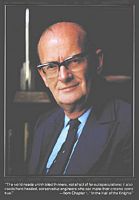 During the recently completed SESI2007 conference, I gave a presentation on who, IMHO, would build the first earth-based Space Elevator. I identified several likely candidates and then narrowed it down to two possibilities; a consortium of US businesses which had struck a deal with the US Government or a Joint Venture between the governments of Dubai (part of the UAE) and India. Without going through the whole presentation, my reasons for this conclusion were this; while the Space Elevator is a source of enormous potential wealth, no government (Dubai/India excepted) would take the risk to build it. Rather, I had identified American business entrepeneurs as people who might well take this risk, but also thought the same about the government of Dubai. This government has much in common with corporations, being flexible, adaptable and able to make decisions without resorting to a myriad of committees. With them having the vision to drive the project (and the finances to pay for it), they need a partner. India struck me as the right one; they are an emerging country, possessing an increasingly well-trained and technological-savvy work force. They are a nuclear power and have a real military and a real space program. They
During the recently completed SESI2007 conference, I gave a presentation on who, IMHO, would build the first earth-based Space Elevator. I identified several likely candidates and then narrowed it down to two possibilities; a consortium of US businesses which had struck a deal with the US Government or a Joint Venture between the governments of Dubai (part of the UAE) and India. Without going through the whole presentation, my reasons for this conclusion were this; while the Space Elevator is a source of enormous potential wealth, no government (Dubai/India excepted) would take the risk to build it. Rather, I had identified American business entrepeneurs as people who might well take this risk, but also thought the same about the government of Dubai. This government has much in common with corporations, being flexible, adaptable and able to make decisions without resorting to a myriad of committees. With them having the vision to drive the project (and the finances to pay for it), they need a partner. India struck me as the right one; they are an emerging country, possessing an increasingly well-trained and technological-savvy work force. They are a nuclear power and have a real military and a real space program. They  also have direct sea-lane access to two of the six potential Earth Port sites, including a favored one off the west coast of Australia. But I had one more reason for picking them, their long-standing rivalry with China. I think India would do much to leapfrog China and participating in the building a Space Elevator would be a perfect project for them.
also have direct sea-lane access to two of the six potential Earth Port sites, including a favored one off the west coast of Australia. But I had one more reason for picking them, their long-standing rivalry with China. I think India would do much to leapfrog China and participating in the building a Space Elevator would be a perfect project for them.
I bring this all up now because of this blog posting from Centauri Dreams. Scientist and Sci-Fi author Gregory Benford recently took a trip to the Asian subcontinent and wrote an absolutely fascinating account of his journey. It has several connections to the Space Elevator (though none are explicitly mentioned). First, he meets with Arthur C. Clarke, the person who is most responsible for the popularization of the idea. Second, he describes India as an awakening giant and has this to say about their rivalry with China;
“Similarly, the Indian space program sees itself as a rival to China, not to the US or Europe. It will be amusing if audacious moves in space come from Asia as a regional competition, just as the US-USSR contest drove the first decades.”
This strikes me as absolutely accurate, though not very amusing. And, as an aside (and something I forgot to mention in my presentation), India will be hosting this years International Astronautical Congress (for the second time), a convention that, in the past, has had a Space Elevator theme as one of its tracks.
Finally, as I blogged about many months ago, I attended a Skeptics conference last year, one where this same Gregory Benford was a speaker. In a Q&A session after his presentation (and in a private conversation after that), he and I talked about a Space Elevator.
Just an interesting coincidence perhaps…
Read the blog entry; it truly is fascinating. And remember what I predict about Dubai (UAE) and India – you heard it here first.

 The Second International Conference and Exposition on Science, Engineering, and Habitation in Space, and the Second Biennial Space Elevator Workshop (heck of a title, yes?) wrapped up yesterday afternoon. The afternoon session was dedicated to putting together a roadmap / plan / whatever you want to call it whereby about 20 or so of the conference participants vowed to work together to further the effort to build a space elevator.
The Second International Conference and Exposition on Science, Engineering, and Habitation in Space, and the Second Biennial Space Elevator Workshop (heck of a title, yes?) wrapped up yesterday afternoon. The afternoon session was dedicated to putting together a roadmap / plan / whatever you want to call it whereby about 20 or so of the conference participants vowed to work together to further the effort to build a space elevator.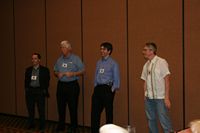
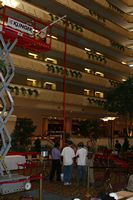
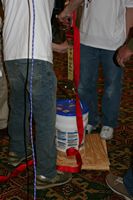
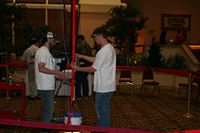
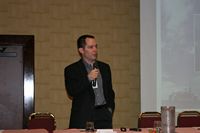

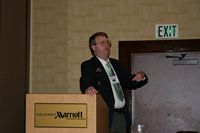
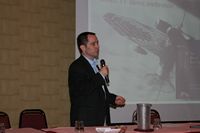
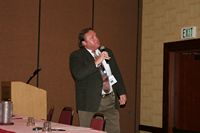
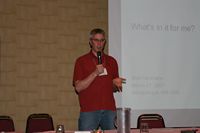
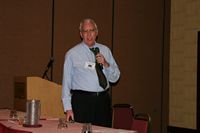
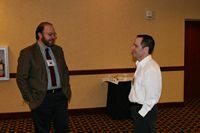
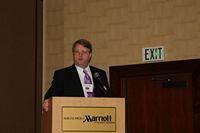
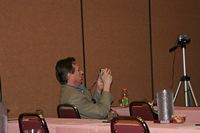
 Bert, from the NSS Space Elevator Special Interest Chapter has found the earliest web-mention I know of for a Space Elevator, this from June of 1991. You can find it
Bert, from the NSS Space Elevator Special Interest Chapter has found the earliest web-mention I know of for a Space Elevator, this from June of 1991. You can find it  The efforts of the Canadian Snowstar team, veterans of the 2006 Space Elevator games, are mentioned. While their team is not yet listed in the Elevator2010’s
The efforts of the Canadian Snowstar team, veterans of the 2006 Space Elevator games, are mentioned. While their team is not yet listed in the Elevator2010’s  In
In  Search engines are weird sometimes; yesterday they found this Howard Lovy June 27, 2004
Search engines are weird sometimes; yesterday they found this Howard Lovy June 27, 2004  But the real prize in this blog entry was its mention of a Dave Barry column on the Space Elevator. The link to the column doesn’t work anymore, but I hunted around and found an archived copy of it – you can view it
But the real prize in this blog entry was its mention of a Dave Barry column on the Space Elevator. The link to the column doesn’t work anymore, but I hunted around and found an archived copy of it – you can view it  The March, 2007 LiftPort General newsletter can be found
The March, 2007 LiftPort General newsletter can be found 
 Over at the
Over at the  Arthur Shay, from
Arthur Shay, from  Over on this Blog’s sidebar, in the Images & Animation section, I’ve posted a video summary of the 2006 Space Elevator Games. It’s the best one I’ve found and I’ve had hopes that it’s producers would put it up on their website, in archives or something. Alas, it has not happened and they have refused to respond to repeated emails on my part.
Over on this Blog’s sidebar, in the Images & Animation section, I’ve posted a video summary of the 2006 Space Elevator Games. It’s the best one I’ve found and I’ve had hopes that it’s producers would put it up on their website, in archives or something. Alas, it has not happened and they have refused to respond to repeated emails on my part.
 One of the organizations I belong to is
One of the organizations I belong to is 
 Just a few days ago, I
Just a few days ago, I 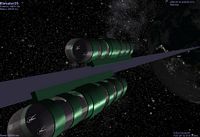
 LiftPort has released their February Contest Newsletter (available
LiftPort has released their February Contest Newsletter (available  Radiation is one of those “gonna’ have to worry about it” issues for Space Elevator passengers (and possibily some of the cargo), but one that can, hopefully be dealt with. If I’m in a climber, I would like some sort of positive reinforcement that whatever shielding has been provided is working and that I’m not getting pinged with too much radiation.
Radiation is one of those “gonna’ have to worry about it” issues for Space Elevator passengers (and possibily some of the cargo), but one that can, hopefully be dealt with. If I’m in a climber, I would like some sort of positive reinforcement that whatever shielding has been provided is working and that I’m not getting pinged with too much radiation. Phil Richter, the Administrative Chair for the Space Engineering and Science Institute, was Dr. David Livingston’s guest on the Space Show this past Tuesday. The podcast for the show is available
Phil Richter, the Administrative Chair for the Space Engineering and Science Institute, was Dr. David Livingston’s guest on the Space Show this past Tuesday. The podcast for the show is available 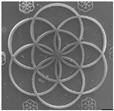 However, I’m going to branch out a bit, though, and begin covering carbon-nanotube news items that are, IMHO, space-elevator related. I don’t think it’s a stretch; we’re not going to have a Space Elevator until carbon-nanotube technology gets to the point where we can build one. News in this area is relevant to all of us who believe that a space elevator is a much more sane way to get out of earth’s gravity well.
However, I’m going to branch out a bit, though, and begin covering carbon-nanotube news items that are, IMHO, space-elevator related. I don’t think it’s a stretch; we’re not going to have a Space Elevator until carbon-nanotube technology gets to the point where we can build one. News in this area is relevant to all of us who believe that a space elevator is a much more sane way to get out of earth’s gravity well. 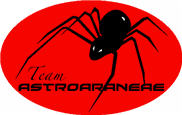
 When the Nova Science Now
When the Nova Science Now  LiftPort has just released their latest, February 2007, newsletter. It can be found
LiftPort has just released their latest, February 2007, newsletter. It can be found  I was surprised to learn that NASA is NOT interested in the Beam Power Competition to power a Space Elevator, nor are they interested in the Tether competition to build a Space Elevator. Ken put it quite bluntly: “NASA’s not interested in Space Elevators…”, at least not as far as the Centennial Challenges are concerned. NASA is looking at the results / winners / new technologies developed out of the Beam Power competition for Lunar exploration purposes and they are looking at the Tether competition for fundamental materials research. However, by partnering with the Spaceward Foundation for these two challenges, NASA is getting what it wants while helping us Space Elevator believers further our goal.
I was surprised to learn that NASA is NOT interested in the Beam Power Competition to power a Space Elevator, nor are they interested in the Tether competition to build a Space Elevator. Ken put it quite bluntly: “NASA’s not interested in Space Elevators…”, at least not as far as the Centennial Challenges are concerned. NASA is looking at the results / winners / new technologies developed out of the Beam Power competition for Lunar exploration purposes and they are looking at the Tether competition for fundamental materials research. However, by partnering with the Spaceward Foundation for these two challenges, NASA is getting what it wants while helping us Space Elevator believers further our goal.